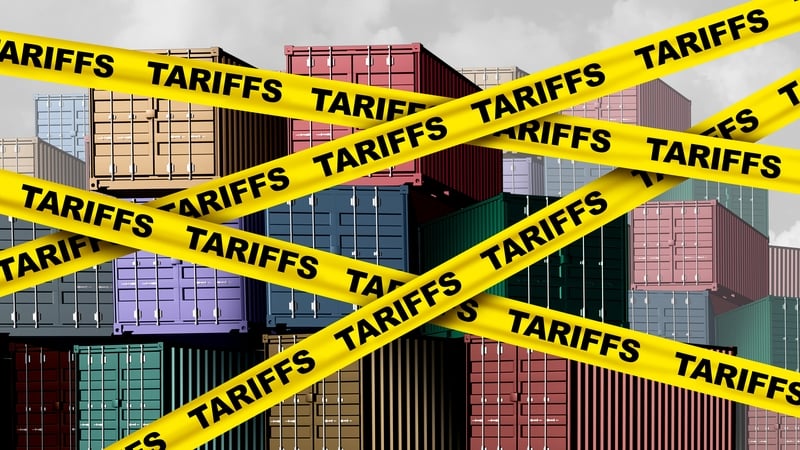US President Donald Trump has made numerous tariff threats since returning to office on January 20, ranging from a universal duty on imports to targeted tariffs on specific sectors or countries, in a bid to get others to meet his policy demands.
Trump’s threats have changed over time, leaving other nations and businesses unclear about what is to come next and creating uncertainty for consumers, triggering a recent stock market selloff.
Here is a roundup of Trump’s trade-related steps and threats.
BROAD TARIFFS
A cornerstone of Trump’s vision includes a phased rollout of universal tariffs on all US imports.
Last month, Trump tasked his economics team with devising plans for reciprocal tariffs on every country that taxes US imports, as well as to counteract non-tariff barriers such as vehicle safety rules that exclude US autos, and value-added taxes that increase their cost.
On March 30, Trump said he was planning to unveil a massive tariff plan on April 2, which he has called “Liberation Day.” The reciprocal tariffs he is set to announce will include all nations.
Global trading partners’ potential counter-tariffs targeting US agricultural, energy and machinery exports could escalate into a worldwide trade war, creating uncertainty for businesses and investors.
SPECIFIC COUNTRIES
Trump’s tariff proposals target several key trade partners including:
MEXICO AND CANADA: The two countries were the largest trade partners of the US in 2024 to November, with Mexico ranked first. Trump’s new 25% tariffs on imports from Mexico and Canada took effect on March 4 as a retaliation for migration and fentanyl trafficking.
The tariffs included a 25% levy on most goods from Mexico and Canada, along with a 10% duty on energy imports from Canada.
Canada primarily exports crude oil and other energy goods, as well as cars and auto parts within the North American auto manufacturing chain. Mexico also exports various goods to the U.S. in the industrial and auto sectors.
Canada hit back with 25% tariffs on C$30 billion ($20.7 billion) worth of US imports, including orange juice, peanut butter, beer, coffee, appliances and motorcycles.
The Canadian government added that it would impose additional tariffs on C$125 billion of US goods if Trump’s tariffs were still in place in 21 days, with the potential inclusion of vehicles, steel, aircraft, beef and pork.

Trump, in his March 4 address to Congress, said further tariffs would follow on April 2, including “reciprocal tariffs” and non-tariff actions to address trade imbalances.
US Commerce Secretary Howard Lutnick said officials might still work out a partial resolution with the two neighbours, adding that they needed to do more on the fentanyl front.
Trump on March 11 walked back planned 50% tariffs on steel and aluminium products from Canada, after a Canadian official withdrew plans for a 25% surcharge on electricity exports to the US.
On March 12, Canada, the biggest foreign supplier of steel and aluminium to the US, said it would impose retaliatory tariffs on US imported goods worth C$29.8 billion ($20 billion) in response to Trump’s steel and aluminium tariffs.
CHINA: Trump levied 10% tariffs across all Chinese imports into the US, effective on February 4, following repeated warnings to Beijing about insufficient measures to halt the flow of illicit drugs into the US.
He followed that up with another 10% duty on Chinese goods, effective March 4, stacking on top of tariffs of up to 25% imposed on Chinese imports during Trump’s first term.

China responded by announcing additional tariffs of 10% to 15% on certain US imports from March 10 and a series of new export restrictions for designated US entities. Later it raised complaints about the US tariffs with the World Trade Organization.
China said on March 12 that it would take all necessary measures to safeguard its rights and interests, after US President Donald Trump increased tariffs on all US steel and aluminium imports.
EUROPE: Trump said the EU and other countries have troubling trade surpluses with the United States. He has said the countries’ products will either be subject to tariffs or he will demand they buy more oil and gas from the US, even though US gas export capacity is near its limits.
The European Commission said in a statement on February 14 that it viewed the “reciprocal” trade policy as a step in the wrong direction.
Trump has threatened a 25% “reciprocal” rate on European goods. Among vulnerable industries is pharmaceuticals, as US firms such as Johnson & Johnson and Pfizer have large plants in Ireland, which is also a major exporter of medical devices.

The European Union on March 12 said it would impose counter-tariffs on €26 billion worth of US goods from next month, in response to blanket US tariffs on steel and aluminium.
On March 13, Trump threatened to slap a 200% tariff on European wine and spirits in response to the EU plan to impose tariffs on American whiskey and other products next month.
PRODUCTS
CARS: On March 26, Trump unveiled a 25% tariff on imported cars and light trucks. The 25% levy would be imposed on top of previous duties on imports of finished vehicles starting on April 3.
Trump’s directive included temporary exemptions for auto parts that are compliant with the US-Mexico-Canada Agreement (USMCA) on trade that Trump negotiated during his first term.
Other major automotive parts imports, identified in Trump’s proclamation as “engines and engine parts, transmissions and powertrain parts, and electrical components,” will be subject to the tariffs on a date to be specified in a Federal Register notice, “but no later than May 3, 2025.”
METALS: On March 12, Trump increased tariffs on all steel and aluminium imports to 25%, and extended the duties to hundreds of downstream products, from nuts and bolts to bulldozer blades and soda cans.
The US is the world’s largest aluminium importer and the second-largest steel importer, with more than half of those volumes coming from Canada, Mexico and Brazil.
Trump on February 25 ordered a new probe into possible new tariffs on copper imports to rebuild US production of the metal critical in electric vehicles, military hardware, semiconductors and a wide range of consumer goods.
The US produces domestically just over half the refined copper it consumes each year.
SEMICONDUCTORS: Trump said tariffs on semiconductor chips would also start at “25%, or higher,” rising substantially over the course of a year, but did not clarify when these will come into effect.
Taiwan Semiconductor Manufacturing, the world’s largest contract chipmaker, makes semiconductors for Nvidia, Apple and other US clients, and generated 70% of its revenue in 2024 from customers based in North America.
LUMBER: Trump on March 1 ordered a new trade investigation that could heap more tariffs on imported lumber, adding to existing duties on Canadian softwood lumber and 25% tariffs on all Canadian and Mexican goods.
ALCOHOL: Trump on March 13 threatened to slap a 200% tariff on wine, cognac and other alcohol imports from Europe, in response to a European Union plan to impose tariffs on American whiskey and other products next month – which itself is a retaliation to Trump’s 25% tariffs on steel and aluminium imports that took effect the day before.




